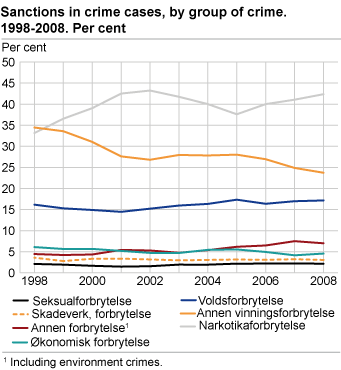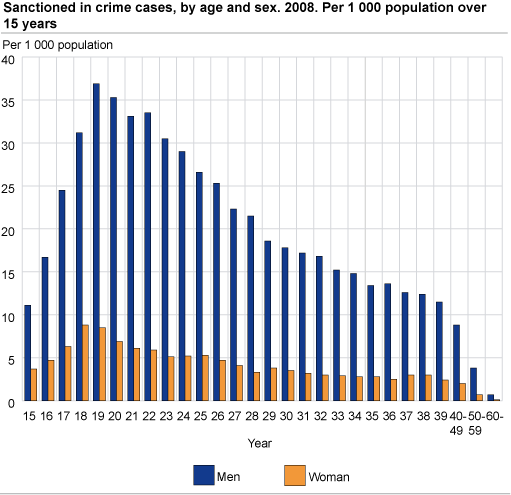Content
Published:
This is an archived release.
Decrease in sanctions
In 2008, 294 000 persons were registered for 338 000 sanctions; 4 and 5 per cent fewer than last year respectively. In total, 7.6 per cent of the population over 15 years of age received one or more sanctions.
A total of 31 400 sanctions were for crimes, which is 11 fewer than the year before, and 307 000 sanctions were given only for misdemeanours; a 5 per cent drop from last year (see figure). All groups of crime had a decrease, and this was largest for offences for profit (1 300), narcotic crimes (1 100) and violent crimes (600). The number of offences for profit was the lowest since 2002. Among the misdemeanours, violation of traffic misdemeanours (14 600) had a large decrease, whilst violation of misdemeanours against the Duty Act had an increase (1 600).
Narcotic crimes principal offence in two out of five crime cases
There has been a shift in the groups of offences that lead to sanctions: From amounting to 33 per cent in 1998, narcotic offences are now the principal offence in 42 per cent of all crime cases. Correspondingly, from amounting to 35 per cent in 1998, offences for profit are now the principal offence in 24 per cent of crime cases. After narcotics, violence is the crime group that has had the strongest growth in numbers in these years, but the share of sanctions with violence as the principal offence has remained stable at between 15 and 17 per cent in the last 10 years (see attached table).
Fewer cases in law court
In 2008, 22 200 sanctions were registered as settled in court; 5 per cent fewer than in 2007. Ninety-five per cent of these cases were settled in the city and district courts, but the largest decrease in per cent was in the lower courts of appeal (9 per cent). The percentage decrease was the largest for fines, with a 19 per cent drop from last year, but conditional sentences had the largest drop in numbers (700). The use of community sentence had, as the only type of sanction, a yearly increase (6 per cent).
The law court’s distributing by type of sanction was 47 per cent unconditional imprisonment, 30 per cent conditional imprisonment, 13 per cent community sentence and 10 per cent fines. The percentage of unconditional imprisonment and fines has been relatively stable in the 10-year period 1999-2008. However, the law court’s distribution by the other types of sanctions has changed considerably in the last 10-year period. In 1999, community sentence made up only 3 per cent, whilst conditional imprisonment made up 39 per cent of the sanctions settled in court (see figure).
23 per cent are women
The statistics for 2008 show that 11.3 per cent of all resident men over the age of 15 were sanctioned more than once, compared to 3.4 per cent of all women. Compared with 2007, the decrease was larger for men (5 per cent) than women (1 per cent). The women’s share is however on the same level as last year, i.e. 23 per cent of all sanctioned and 17 of all sanctioned for crimes.
Decrease in all age groups
Compared to last year, there was a decrease in sanctions for all age groups, but the percentage was largest for young persons aged 15-17 (11 per cent). Among those sanctioned for crimes, it is still those aged around 20 that are most over-represented, and this applies to both men and women. In 2008, 3.4 per cent of all resident men and 0.8 per cent of all resident women aged 18-20 were sanctioned for one or more crimes (see figure). However, among those only sanctioned for misdemeanours, the age difference is small, especially among those aged 20-49, where approximately one out of ten of the population are sanctioned.
Fewer fined for traffic misdemeanours
A total of 84 per cent of the misdemeanour cases are sanctioned with on the spot fines. Of the 256 000 on the spot fines, 241 000 (95 per cent) were for traffic misdemeanours, of which 90 per cent concerned illegal speeds. For the first time since 2002, there has been a decrease in on the spot fines for traffic misdemeanours, and in 2008 13 900 fewer on the spot fines concerning illegal speeds were given compared to 2007 (see figure).
In 2008, 40 100 on the spot fines were given for violating the Traffic Act in Akershus, which is the highest amount among the counties. However, in relation to the population size, Vestfold has the largest amount (121 per 1 000 population over 15 years, see figure).
Supplementary registration in Norwegian Central Penal Register (SSP)The selection for statistics on sanctions is the number of sanctions registered in the originator register during the statistical year (see About the statistics ). The amount of late registrations each year can vary, which was especially the case in 2007 and partly also in 2008. This appears among other things in that 6.8 per cent and 3.3 per cent of all sanctions registered in SSP, in correspondingly 2007 and 2008, were pronounced 2 years or more preceding the statistical year. In the years 1997-2006, the corresponding percentage was 0.9 on average.
Most of the late registrations apply to ticket fines for crimes. This involves a considerably larger number of sanctions and sanctioned in several of the tables on crimes in 2008, compared to 1997-2006, but a lower number than 2007. This has most significance to the number of minor narcotic crimes and assaults. The late registered sanctions are of no consequence to the number of sanctions in law courts or in cases with misdemeanours as the principal offence. |
Tables
Contact
-
Sigmund Book Mohn
E-mail: sigmund.mohn@ssb.no
tel.: (+47) 94 32 77 22
-
Reid Jone Stene
E-mail: reid.jone.stene@ssb.no
tel.: (+47) 99 02 22 01






